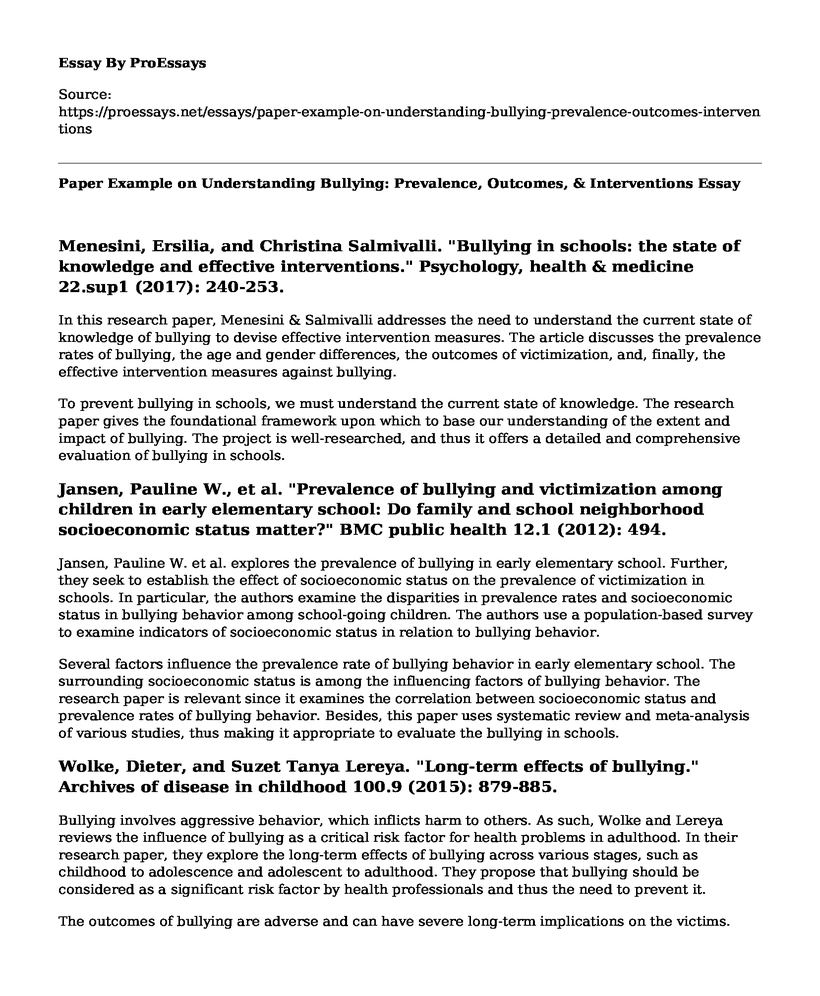Menesini, Ersilia, and Christina Salmivalli. "Bullying in schools: the state of knowledge and effective interventions." Psychology, health & medicine 22.sup1 (2017): 240-253.
In this research paper, Menesini & Salmivalli addresses the need to understand the current state of knowledge of bullying to devise effective intervention measures. The article discusses the prevalence rates of bullying, the age and gender differences, the outcomes of victimization, and, finally, the effective intervention measures against bullying.
To prevent bullying in schools, we must understand the current state of knowledge. The research paper gives the foundational framework upon which to base our understanding of the extent and impact of bullying. The project is well-researched, and thus it offers a detailed and comprehensive evaluation of bullying in schools.
Jansen, Pauline W., et al. "Prevalence of bullying and victimization among children in early elementary school: Do family and school neighborhood socioeconomic status matter?" BMC public health 12.1 (2012): 494.
Jansen, Pauline W. et al. explores the prevalence of bullying in early elementary school. Further, they seek to establish the effect of socioeconomic status on the prevalence of victimization in schools. In particular, the authors examine the disparities in prevalence rates and socioeconomic status in bullying behavior among school-going children. The authors use a population-based survey to examine indicators of socioeconomic status in relation to bullying behavior.
Several factors influence the prevalence rate of bullying behavior in early elementary school. The surrounding socioeconomic status is among the influencing factors of bullying behavior. The research paper is relevant since it examines the correlation between socioeconomic status and prevalence rates of bullying behavior. Besides, this paper uses systematic review and meta-analysis of various studies, thus making it appropriate to evaluate the bullying in schools.
Wolke, Dieter, and Suzet Tanya Lereya. "Long-term effects of bullying." Archives of disease in childhood 100.9 (2015): 879-885.
Bullying involves aggressive behavior, which inflicts harm to others. As such, Wolke and Lereya reviews the influence of bullying as a critical risk factor for health problems in adulthood. In their research paper, they explore the long-term effects of bullying across various stages, such as childhood to adolescence and adolescent to adulthood. They propose that bullying should be considered as a significant risk factor by health professionals and thus the need to prevent it.
The outcomes of bullying are adverse and can have severe long-term implications on the victims. Therefore, this research paper is relevant to the current topic as it discusses the impact of bullying on the physical and mental health of victims. Besides, the review is well researched to provide extensive knowledge on the effects of bullying; thus, it is an appropriate source in evaluating bullying in schools.
Cite this page
Paper Example on Understanding Bullying: Prevalence, Outcomes, & Interventions. (2023, May 23). Retrieved from https://proessays.net/essays/paper-example-on-understanding-bullying-prevalence-outcomes-interventions
If you are the original author of this essay and no longer wish to have it published on the ProEssays website, please click below to request its removal:
- Gender Gap Essay Example
- Torvald's View of His Wife and "A Woman's Place" - Critical Essay
- The Impact of Domestic Violence on Children Annotated Bibliography
- The Role of Women in the Hebrew Bible Essay Example
- Essay Sample on Sexual and Physical Abuse
- Rising Violence in Nursing: An Age-Old Problem Now Receiving Due Attention - Essay Sample
- Organizing Legal Immigration: The Role of the PRM's Office of International Migration (PIM) - Essay Sample







